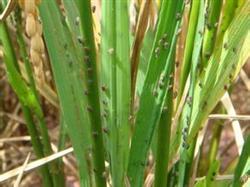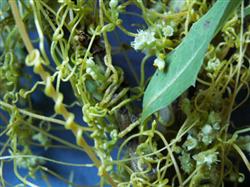Identification and Control of Rice Diseases and insect pests (2)

▲ rice evil seedling disease: also known as "overgrowth disease" or "preemptive disease" is a fungal disease caused by the seeds of susceptible varieties. Those who feel seriously ill wither and die after growing at the seedling stage. The leaves with light susceptibility are slender, yellowish, the plants are only long, the flag leaves become longer, tilt, heading ahead of time, the grains become larger and are easy to drop. The growth of fibrous roots on the first and second streets at the base of the neck is the main symptom. Control methods: (1) selection of disease-resistant varieties. (2) the bacteria could be killed by soaking the seeds with 1500 times "402" fungicide solution for 72 hours. Or soaking seeds with 5000 times solution of 25% "make 100 grams" can also kill germs. The heading Jun in the picture is a diseased plant of evil seedling disease. The comparative experiment of soaking seeds with "402" in ▲. Methods: half of the seeds collected from the diseased plants of last year were soaked with "402", and the other half were not soaked as control seedlings. Results: the spike of the seed soaked was normal, the spike of the plant without soaking seed increased earlier, and the grain became larger and was easy to drop. There are anatropous fibrous roots on the node, which is a typical plant of evil seedling disease. ▲ rice bacterial blight (Xanthomonas oryzae pv. oryzae): bacterial disease, which is the object of national plant quarantine. It is mainly transmitted by pathogenic seeds and diseased rice straw. Damage to rice leaves, causing plants to wilt to death, which has a great impact on rice yield. Prevention and control methods: (1) to burn the rice straw in the diseased field and put an end to the source of infection. (2) choose disease-free or disease-resistant varieties. (3) do a good job in seed treatment and soak the seeds with "402" fungicide before sowing to kill germs. (4) at the initial stage of the disease, "Yekuning" or "Dysenammonium EC" and agricultural "penicillin" were sprayed with water according to the instructions.
- Prev

Matters needing attention in Young panicle differentiation of Rice
Matters needing attention in Young panicle differentiation of Rice
- Next

Control of three main diseases of soybean
What does soybean dodder look like? What if soybean dodder happens? Dodder is also known as yellow rattan and tangled rice seedlings. It's a malignant weed. It harms a variety of crops and can cause the loss of soybean production, which is common in all parts of the country. (1) Morphology: the stem of soybean cocoon silk is yellow, orange or yellowish green, smooth and glabrous.
Related
- The first cup of black tea in spring, the flavor and history of tea gardens in Kenya, Africa
- The computer can not only choose potatoes, but also grow tea rice. AI will grow winter oolong tea champion.
- It is not only the inflated tea bitten by insects, but also engraved with the four seasons tea in Beipu.
- The Oriental Beauty Tea Festival in Zhuxian County takes the stage at the weekend to experience the plus-size feast of oil tea.
- & quot; Oriental Beauty Tea & Exploration of Emei in Hsinchu, the hometown of quot;
- The new variety of strawberry "Tainong 1" dessert is the first choice with mellow aroma. Crimson gorgeous
- History of Tea in Taiwan: from Wild Inner Mountain to Export Tea Garden
- Two types of Taiwan Oriental Beauty Black Tea won the British three-Star Award for Childhood Tea Xiang Zhang Jiaqi changed from pilot to champion tea maker.
- Banana species and varieties: the planting history of Taiwan Xianren banana and dwarf banana is long, is banana disease resistant?
- Coffee planting Technology: Qianjie Coffee from Seedling to harvesting

